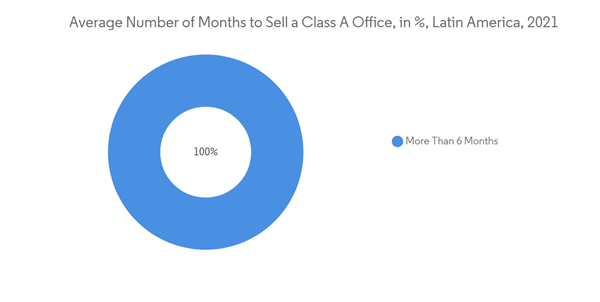Despite setbacks in 2020 and 2021 due to the COVID-19 pandemic, the commercial real estate industry in Latin America has a positive outlook for 2022. The industrial segment continues to perform well, despite some surprises and overly negative forecasts in the retail commercial real estate markets. Overall, the multi-family segment appears to have a huge opportunity.
The increased time to complete sales, unfavorable local economies, and a drop in sale price negatively affected the performance of Class A office sales in Latin America during the first half of 2021.
With the emergence of PropTech, the commercial real estate industry in Latin America is starting to take off. Mexico, Brazil, Chile, and Argentina are among the countries that have embraced disruptive technology in the real estate industry. In total, there are more than 350 PropTech companies in Latin America, with the majority of them based in Brazil.
Key Market Trends
Recovery in Premium Office Segment Boosting Commercial Real Estate Market in Latin America
In Latin American cities with populations of less than two million people, there are signs of a recovery in the market for premium offices.
In 2021, in cities with populations under 2 million, such as Monterrey and Montevideo, the price per square foot on sales of prime office space exceeded USD 280, indicating a severe lack of inventory. At the same time, leases for premium offices in those cities surpassed USD 1.68 per square foot, indicating that there is still room for more supply.
In June 2021, the WTC Prime Office Index Latam's expectations indicator was -19%. This confirmed that expectations had improved since December 2020, when they were -32%.
In the premium office market segment, innovation will be critical to success. In this regard, some of the new World Trade Centers are setting new benchmarks. WTC Montevideo (a building complex in Montevideo, Uruguay) recently completed the construction of a second tower in the city's free-trade zone. It was created as a niche player, focusing on service-exporting businesses. Coworking and startup spaces are also available in the building.
WTC Goiânia (a business networking company in Brazil) was designed around a concept that will change the mix of living spaces, work, commerce, and social relationships in the most important city for Brazilian agribusiness. A hotel, offices, apartments, commercial areas (including a 2,635 sq. m. shopping mall), and meeting spaces, including a convention center, will be housed in the two towers.
Growth in Infrastructure Sector Driving the Market
Latin America offers a wide variety of infrastructure investment and development opportunities. Institutional investors will find more opportunities in certain parts of the region than in others.
Many regions around the world have had infrastructure gaps for years. The Global Infrastructure Hub estimates that by 2040, there will be a USD 15 trillion gap between projected investment and the amount required to provide adequate infrastructure.
According to the Inter-American Development Bank, the gap in Latin America is estimated to be 2.5% of GDP or about USD 150 billion per year. Sanitation, communication, logistics, housing, and energy have all accounted for a significant portion of this.
Brazil has established itself as the country with the best prospects right now. It announced the resumption of public auctions in the infrastructure sector, with six taking place in H1 2021. The concession of coastal highways (worth USD 556 million) and two commuter rail lines (worth USD 467 million) are the country’s two largest projects.
Outside of Brazil, investors have also discovered opportunities. In 2021, CPPIB, along with IDEAL and the Ontario Teachers' Pension Plan, invested in toll roads in Mexico. It also invested in natural gas pipelines with TgP in Peru and toll roads with Grupo Costanera in Chile.
Investors have found a very mature infrastructure market in Chile, which is an OECD member, and it will not be difficult for them to attract capital.
Competitive Landscape
The Latin American commercial real estate market is highly fragmented due to the presence of a vast number of players. Some of the major players in the Latin American commercial real estate market are Quality Inmobiliaria, Patio Group, Boston Andes Capital, Urbanizadora Paranoazinho, etc. Commercial real estate is changing for the better as a result of the rapid growth of new technologies. Brokers, property managers, developers, and tenants are updating themselves to increase productivity while saving money.
Additional Benefits:
- The market estimate (ME) sheet in Excel format
- 3 months of analyst support
This product will be delivered within 2 business days.
Table of Contents
Companies Mentioned (Partial List)
A selection of companies mentioned in this report includes, but is not limited to:
- Quality Inmobiliaria - Patio Group - Boston Andes Capital - Urbanizadora Paranoazinho - TRK Imoveis - Colliers - Pulso Inmobiliario - JLL - CBRE - Grupoguia - Pilay Inmobiliaria - Rafael Angel Inmobiliaria - Century 21 Colombia - Redpiso - DNA Imoveis









